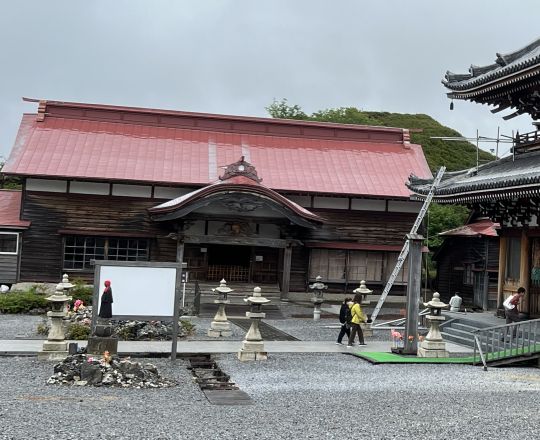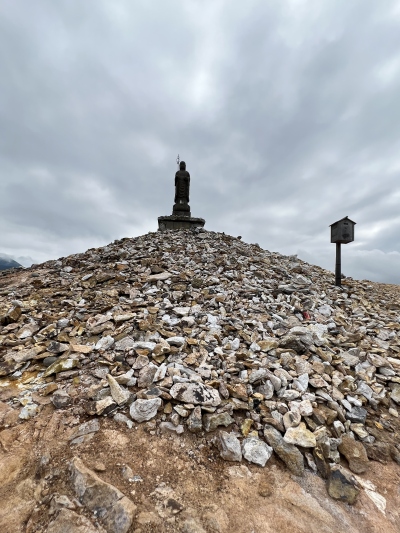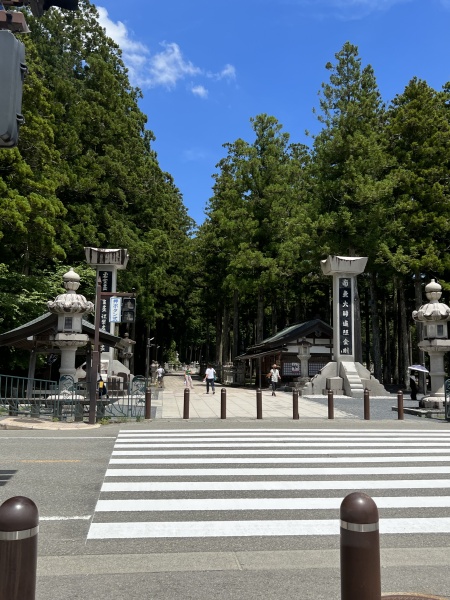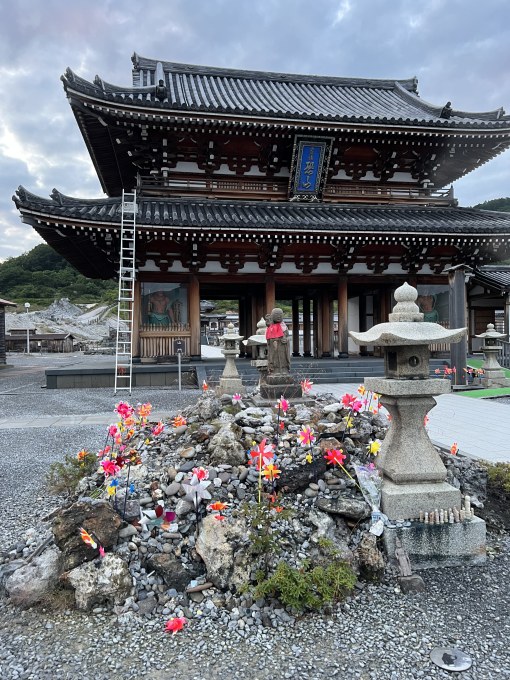Now that Japan has achieved a largest number of turists from abroad, most of those who are accustomed to visiting this country may know well where in Japan they should go to enjoy themselves.
However, if you knew Japanese way of life more deeply, especially about their religious and spiritual idea, you would have a fresh and amazing experience by visiting Osorezan(恐山).

Osorezan is home to many spirits of not only those who died but also those who are still alive.
Osorezan is basically a Buddhist temple, but not the same as other Buddhist temples in Japan.
I have visited Osorezan three times until now and each time I have had enigmatic impression.
I’m going to explain what I experienced here.
Osorezan is a Buddhist temple which has many unique features
Today many foreign tourists are visiting our country Japan.
Some are very interested in Japan’s temples, shrines, and its religious aspects and customs.
They may already have been to many such places and had experiences as such.
We Japanese basically feel very happy they recognized our country’s tradition, history and beautifulness.

One of Japan’s typical temple: a Soto sect temple, which is next to my town.
However, Osorezan, one of big Buddhist temples in Aomori prefecture, northern area of Japan, looks much different from other temples.
Frankly speaking, the precinct is likened to the scenery of hell in Buddhism.

You’ll meet these two stone statues on the way by bus or driving a rented car to Osorezan, about 1km ahead of its main gate.
The man standing with two horns on his head is Keneo(懸衣翁), and the old woman sitting on one knee is Datsueba(奪衣婆).
In Buddhism, they are said to weigh sins of those who died and decide to make them driven into hell or not.
- You can access to Osorezan from in April to in October: located in highlands of nothern province, the temple usually cannot be accessed due to deep snow during the other months.
- If you start from Tokyo, take Tohoku Shinkansen from Tokyo station to Aomori station.(It takes at least about well 3 and a half hours if you take Limited Express “Hayabusa”, the fastest Tohoku Shinkansen service.)

Aomori station
At Aomori station, take Aoimori Tetsudo bound for Noheji(野辺地).
There at Noheji station, change trains and take Ominatosen(大湊線) for Ominato(大湊). Get off at Simokita(下北) station, one station before Ominato, the last stop.
At the station there is a bus service to Osorezan, its last stop. Its one-way ware is ¥810(as of 2024/10). It’s convenient to buy the round-way chicket(¥1,620) at Shimokita station.
As you can notice from this map below, Osorezan is located in the middle of many mountains, and its altitude is 879m(Mt.Osore).
In old days, when there were no cars or buses, believers used to climbed up to Osorezan on foot for the purpose of their Buddhist service. The road at that time was much rougher, steeper ,and more dangerous than today.

Beside Keneo and Datsueba statues can you see this scene.
The stream is called “Sanzunokawa(三途の川)”, and said to devide this world and another world.
And the red, round bridge is “Taikobashi(太鼓橋)”: by crossing it you shall die and be judged about the sin you have commit in this world.
When you enter its main gate, which is called “Somon(総門)”, you’ll see the large “Sanmon(山門、temple gate)” about 100m ahead.

In Osorezan, you can reach “Sanmon(山門:above)” after about 100ms’ walk from “Soumon(総門, main gate)”.
Hondo(本堂) of Osorezan is next to Sanmon. And after going through Sanmon, you can see Jizodo(地蔵堂) in your front, about the same distance from Somon to Sanmon.

Hondo(本堂), meaning the main hall of a Buddhist temple.
Osorezan’s Hondo, with a red roof, stands by the Somon.
And the temple’s Honzon(本尊), which is the principal image of the temple, is a kind of Jizo(EnmeiJizo, 延命地蔵) , and he is enshrined here in Honzon.

Jizodo(地蔵堂): Osorezan’s Sando(参道、main approach) is directly led up to this building, which means Jizodo is Osorezan’s heart.
You’ll be surprised to see the specious, stark landscape
So, the whole precinct of Osorezan is seemingly limited to just this dimension.
Never!
You should just notice once you stand in front of Jizodo or around it.
From between Sanmon and Jizodo, especially, you can see specious, hell-like scenery on your left.
That is no doubt said one of Osorezan’s hearts.

Osorezan’s precinct has been likened to the scenery of hell.
While walking around here, you will find many pinwheels stand on the ground.
They are put by parents to console their deceased children.
And in Buddhism, Jizo, who is Osorezan’s Honzon(principal image), is said to have the role in saving children, babies, pregnant women, and travelers.
So, its precinct, which is very, very wide, is never the same as what you have seen in many other temples!
It may be said that it’s like the surface of the Mars or the Moon: there are no plants, no weeds and no animals.
It is said that this is because the area where Osorezan is located takes on strongly acidic soil.
In fact, Osorezan’s ares is thought of as an active volcano and you can notice sulfuric smell when you arrive at Osorezan.
So, in this stark, hell-like area only can you see are pebble ground, rocky piles with a few small temple buildings, graves, and Jizo statues made of stone.

Osorezan is reined by silence, under Jizo Buddhist saints’ cradle・・・
From this weird landscape, however, Osorezan has long been said one of the most sacred temples. Osorezan is compared to the other two greatest temples, Koyasan in Wakayama prefecture, and Hieizan in Kyoto and Shiga prefecture in Japan: these temples are called “Japan’s three great spiritual places”.

The main gate of Koyasan, which was founded more than a thousand years by Kukai(空海), one of the greatest dignitaries and the founder of Shingon sect(真言宗).
But Osorezan seems very different from the other two temples, because it has long been thought of as home to deceased people’s spirits.
So, we often hear people, who believe Osorezan, say that “all the people go to ‘Oyama(お山)’ once they pass away”. Oyama means Osorezan.

I think this way: by consoling deceased people, their family members, who are now alive, are also consoled.
This lake is caldera lake, called Usoriyamako(宇曾利山湖), and the mountain beyond the lake is Kamafuseyama(釜臥山). They also form Osorezan’s scenic feature.
Someone seems to have put two flower bouquets on the lakeshore like this: perhaps they are for consoling relatives deceased.
Once I have also seen a young man on the shore scream at the lake, “Okasan(お母さん、Mother)!”.
Visiting Osorezan may lead to understanding Japanese view of life and death
Jikisai Minami(南直哉), One of Osorezan’s top degnitaries, has written many books, most of which are, I’d say, about the way to live in this world, the way to think about dying, and the worth of living.
If you stay at Osorezan’s shukubo(宿坊), meaning temple lodging, called Kisshokaku(吉祥閣), you may find his book in your room. Or if you’re lucky, you may be able to hear his lecture in Osorezan’s Jizodo. Although he speaks only Japanese and most of his book are written in Japanese, at least one of his books is translated into English.
Other than that, if you’re interested, please surf the Internet for other books with the ward “Jikisai Minami”.
In his books he talks in various ways about humans’ life, how to live, and how to think of this world and another world. Sometimes he uses very difficult, scholarly explanations and readers may get confused, but his earnest posture toward “death” will be enough for them to be impressed.
In the end, as for me, there is one thing that can be apparent: you, foreign people, may notice the difference between you and Japanese in the way of thinking about death: the spirit is eternal and that’s why many Japanese people try to come to this place to meet their deceased relatives.






LEAVE A REPLY